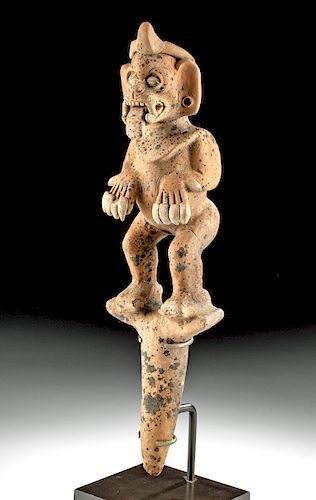Exceptional Veracruz Pottery Staff - Jaguar Shaman
Lot 51
About Seller
Artemis Fine Arts
686 S Taylor Ave, Ste 106
Louisville, CO 80027
United States
Selling antiquities, ancient and ethnographic art online since 1993, Artemis Gallery specializes in Classical Antiquities (Egyptian, Greek, Roman, Near Eastern), Asian, Pre-Columbian, African / Tribal / Oceanographic art. Our extensive inventory includes pottery, stone, metal, wood, glass and textil...Read more
Estimate:
$16,000 - $24,000
Absentee vs Live bid
Two ways to bid:
- Leave a max absentee bid and the platform will bid on your behalf up to your maximum bid during the live auction.
- Bid live during the auction and your bids will be submitted real-time to the auctioneer.
Bid Increments
| Price | Bid Increment |
|---|---|
| $0 | $25 |
| $300 | $50 |
| $1,000 | $100 |
| $2,000 | $250 |
| $5,000 | $500 |
| $10,000 | $1,000 |
| $20,000 | $2,500 |
| $50,000 | $5,000 |
| $100,000 | $10,000 |
| $200,000 | $20,000 |
About Auction
By Artemis Fine Arts
Oct 3, 2019
Set Reminder
2019-10-03 10:00:00
2019-10-03 10:00:00
America/New_York
Bidsquare
Bidsquare : Exceptional Day 2: Pre-Columbian & Tribal Art
https://www.bidsquare.com/auctions/artemis-gallery/exceptional-day-2-pre-columbian-tribal-art-4453
Day 2 of an important 2-day auction featuring exceptional, museum-worthy examples of Pre-Columbian from the ancient Americas, Native American, African / Tribal, Oceanic, Spanish Colonial and fossils. Artemis Fine Arts info@artemisfinearts.com
Day 2 of an important 2-day auction featuring exceptional, museum-worthy examples of Pre-Columbian from the ancient Americas, Native American, African / Tribal, Oceanic, Spanish Colonial and fossils. Artemis Fine Arts info@artemisfinearts.com
- Lot Description
Pre-Columbian, Mexico, Veracruz culture, also known as Totonac (Totonaca), Remojadas, ca. 300 to 600 CE. A heavy ceramic staff finial or possibly boundary marker, capped by a jaguar-like shaman figure standing perched atop a T-shaped stand with a stake at its base. The figure has a short snout, four huge fangs, and a long, extended tongue. Giant ears, each perforated as if they once held earrings of precious metal or feathers, adorn the sides of the head, while a headdress with a single raised horn - often a signifier of shamanism - perches atop the wrinkled brow. The figure wears a large pectoral and nothing else. Its hands are extended, the fingers delineated by massive, jaguar-like claws. The figure crouches as if engaged in a dance. Size: 3.4" W x 13.6" H (8.6 cm x 34.5 cm); 14.7" H (37.3 cm) on included custom stand.
Who did this figure represent? Excavations near the modern Mexican town of Remojadas have revealed two types of impressive, detailed pottery figures from the Veracruz period: the Sonrientes, the joyous "smiling faces", and figures like this one, more serious, with elaborate costumes, themes, and sometimes props that all seem to point towards religious or political ceremonies. These figures are often found with the bodies broken into pieces but the heads largely intact, as scholars believe they were ritually destroyed as burial offerings.
Provenance: ex-Merrin Gallery, New York, USA; ex-private Chicago, Illinois, USA collection, formed around 1960
All items legal to buy/sell under U.S. Statute covering cultural patrimony Code 2600, CHAPTER 14, and are guaranteed to be as described or your money back.
A Certificate of Authenticity will accompany all winning bids.
We ship worldwide and handle all shipping in-house for your convenience.
#148169Repaired in multiple places - at the neck, buttocks, hands, feet, and upper part of the staff - with repairs well done and unobtrusive. Excellent deposits on surface. Small loss to headdress and to claws.Condition
- Shipping Info
-
All shipping is handled in-house for your convenience. Your invoice from Artemis Gallery will include shipping calculation instructions. If in doubt, please inquire BEFORE bidding for estimated shipping costs for individual items.
-
- Buyer's Premium



 EUR
EUR CAD
CAD AUD
AUD GBP
GBP MXN
MXN HKD
HKD CNY
CNY MYR
MYR SEK
SEK SGD
SGD CHF
CHF THB
THB














